Motherboard Products: Intel Performance
We cannot disclose performance results yet for the Bearlake motherboards nor give general indications on how it compares to the P965 but all will be revealed on May 21st. Let's just say we were surprised with our test results over the last few weeks. (You'll have to wait to find out if we were surprised in a good or a bad way.) In the meantime we have three boards from ASUS, Gigabyte, and MSI to show you today with more coming shortly.
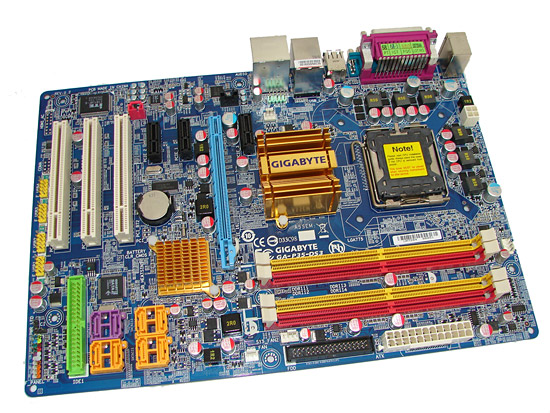
The spiritual successor to Gigabyte's highly acclaimed GA-965P-DS3 series is the new GA-P35-DS3R. The board features a single x16 PCI Express slot, two x1 PCI Express slots, and three PCI 2.2 slots. The new ICH9R chipset is also included with six SATA 3Gb/s ports, and two additional SATA 3Gb/s ports come from the now standard JMicron JMB363 chipset that also provides IDE functionality. Audio is provided by the new Realtek ALC889A chipset and the board features Gigabyte's Ultra Durable 2 technology. This technology is a combination of ferrite core choke coils, low RDS MOSFETs, and solid aluminum polymer capacitors on the board.
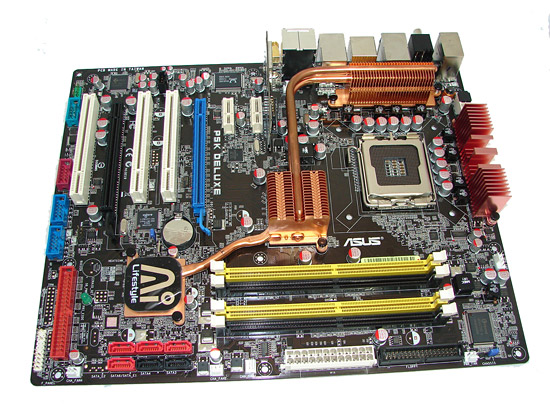
The ASUS P5K Deluxe is based on the P35 and ICH9R chipsets. The board features two x16 PCI Express slots (x16 electrical and x4 electrical for CrossFire), two x1 PCI Express slots, and three PCI 2.2 slots. The ICH9R Southbridge features six Serial ATA 3Gb/s ports with RAID 0, 1, 5, and 10 support. ASUS also supplies the JMicron JMB363 SATA controller that provides two e-SATA ports and the single IDE connector. The board is equipped with an ADI 1988B 8-channel HD audio codec and features dual Gigabit LAN. The ASUS WiFi-AP Solo IEEE 802.11g wireless card is included as is IEEE 1394a support from the Agere FW322 chipset.
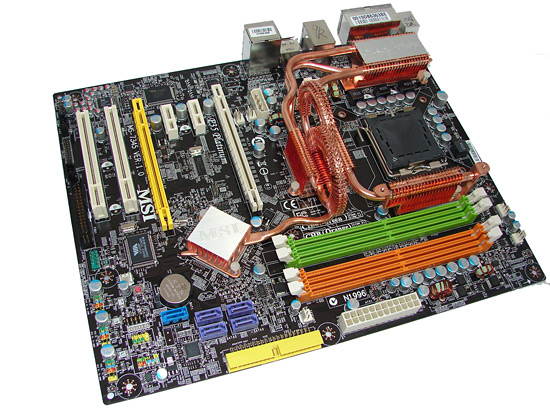
The MSI P35 Platinum is also based on the P35 and ICH9R chipsets. The board features two x16 PCI Express slots (x16 electrical and x4 electrical for CrossFire), two x1 PCI Express slots, and two PCI 2.2 slots. The ICH9R Southbridge features six Serial ATA 3Gb/s ports with MSI utilizing two for e-SATA duties. MSI utilizes the Marvell 88SE6111 chipset that provides a single 3Gb/s SATA and IDE ATA133 port on the board. The board is equipped with the new Realtek ALC888T 8-channel HD audio codec that features support for VoIP. The board features a single Gigabit LAN port and IEEE 1394a support from the VIA VT6308 chipset.
AMD uATX
We have several uATX boards featuring the AM2 processor series that we will present in our upcoming roundup that can only be described at this time as an editor killing review. The products we will briefly cover today are just a few examples of the boards that will be included. While most of our boards are based on the AMD 690G and NVIDIA 6150 technology we do have a couple of AMD/ATI RS485 boards along with a VIA K8M890 based board. We will also include results from the new NVIDIA 7050 chipset.
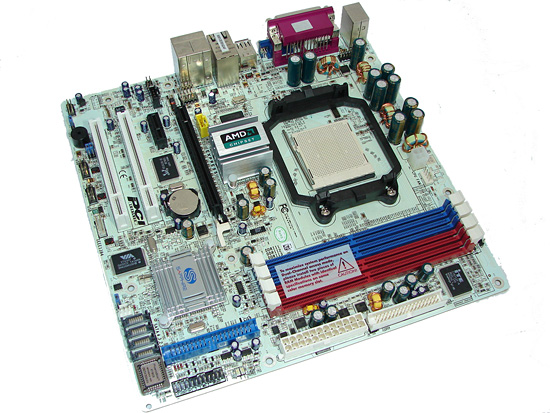
The Sapphire PI-AM2RS690MHD board is based on the AMD690G chipset that offers very good onboard video performance via the ATI X1250 with the ability to upgrade to the latest graphics card technology via the x16 PCI Express slot. The board supports 8GB of DDR2 memory, single x1 PCI Express slot, two PCI 2.2 slots, HD audio via the Realtek ALC882D, and IEEE 1394a from the VIA VT6306 chipset. The board also features HDMI, VGA, and DVI output along with four 3Gb/s SATA ports and a single IDE connector via the tried and true SB600 Southbridge. With the latest BIOS we are now over 300HTT in our overclocking tests along with the board performing superbly overall.
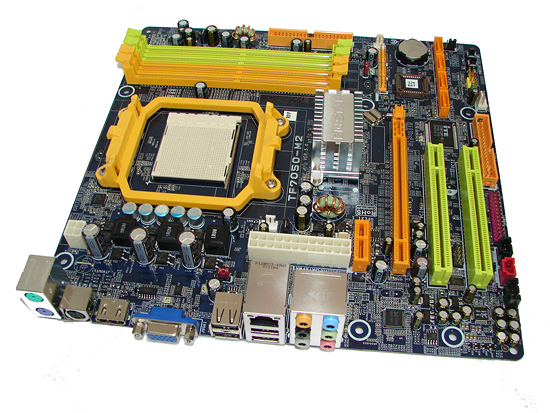
The Biostar TF7050-M2 board is based upon the new NVIDIA GeForce 7050PV and nForce 630A chipsets that offer very good system performance in a uATX form factor. The board has one x16 PCI Express slot, one x1 PCI Express slot, and two PCI slots. The board supports 4GB of DDR2 memory, HD audio via the Realtek ALC888, Gigabit LAN via the Realtek RTL-8111B Fast Ethernet, and four Serial ATA 3Gb/s ports along with a single ATA133 IDE connector. The board also features VGA and HDMI outputs. Additional details about this chipset will be available on May 15th.
We cannot disclose performance results yet for the Bearlake motherboards nor give general indications on how it compares to the P965 but all will be revealed on May 21st. Let's just say we were surprised with our test results over the last few weeks. (You'll have to wait to find out if we were surprised in a good or a bad way.) In the meantime we have three boards from ASUS, Gigabyte, and MSI to show you today with more coming shortly.

The spiritual successor to Gigabyte's highly acclaimed GA-965P-DS3 series is the new GA-P35-DS3R. The board features a single x16 PCI Express slot, two x1 PCI Express slots, and three PCI 2.2 slots. The new ICH9R chipset is also included with six SATA 3Gb/s ports, and two additional SATA 3Gb/s ports come from the now standard JMicron JMB363 chipset that also provides IDE functionality. Audio is provided by the new Realtek ALC889A chipset and the board features Gigabyte's Ultra Durable 2 technology. This technology is a combination of ferrite core choke coils, low RDS MOSFETs, and solid aluminum polymer capacitors on the board.

The ASUS P5K Deluxe is based on the P35 and ICH9R chipsets. The board features two x16 PCI Express slots (x16 electrical and x4 electrical for CrossFire), two x1 PCI Express slots, and three PCI 2.2 slots. The ICH9R Southbridge features six Serial ATA 3Gb/s ports with RAID 0, 1, 5, and 10 support. ASUS also supplies the JMicron JMB363 SATA controller that provides two e-SATA ports and the single IDE connector. The board is equipped with an ADI 1988B 8-channel HD audio codec and features dual Gigabit LAN. The ASUS WiFi-AP Solo IEEE 802.11g wireless card is included as is IEEE 1394a support from the Agere FW322 chipset.

The MSI P35 Platinum is also based on the P35 and ICH9R chipsets. The board features two x16 PCI Express slots (x16 electrical and x4 electrical for CrossFire), two x1 PCI Express slots, and two PCI 2.2 slots. The ICH9R Southbridge features six Serial ATA 3Gb/s ports with MSI utilizing two for e-SATA duties. MSI utilizes the Marvell 88SE6111 chipset that provides a single 3Gb/s SATA and IDE ATA133 port on the board. The board is equipped with the new Realtek ALC888T 8-channel HD audio codec that features support for VoIP. The board features a single Gigabit LAN port and IEEE 1394a support from the VIA VT6308 chipset.
AMD uATX
We have several uATX boards featuring the AM2 processor series that we will present in our upcoming roundup that can only be described at this time as an editor killing review. The products we will briefly cover today are just a few examples of the boards that will be included. While most of our boards are based on the AMD 690G and NVIDIA 6150 technology we do have a couple of AMD/ATI RS485 boards along with a VIA K8M890 based board. We will also include results from the new NVIDIA 7050 chipset.

The Sapphire PI-AM2RS690MHD board is based on the AMD690G chipset that offers very good onboard video performance via the ATI X1250 with the ability to upgrade to the latest graphics card technology via the x16 PCI Express slot. The board supports 8GB of DDR2 memory, single x1 PCI Express slot, two PCI 2.2 slots, HD audio via the Realtek ALC882D, and IEEE 1394a from the VIA VT6306 chipset. The board also features HDMI, VGA, and DVI output along with four 3Gb/s SATA ports and a single IDE connector via the tried and true SB600 Southbridge. With the latest BIOS we are now over 300HTT in our overclocking tests along with the board performing superbly overall.

The Biostar TF7050-M2 board is based upon the new NVIDIA GeForce 7050PV and nForce 630A chipsets that offer very good system performance in a uATX form factor. The board has one x16 PCI Express slot, one x1 PCI Express slot, and two PCI slots. The board supports 4GB of DDR2 memory, HD audio via the Realtek ALC888, Gigabit LAN via the Realtek RTL-8111B Fast Ethernet, and four Serial ATA 3Gb/s ports along with a single ATA133 IDE connector. The board also features VGA and HDMI outputs. Additional details about this chipset will be available on May 15th.










33 Comments
View All Comments
defter - Thursday, May 3, 2007 - link
Why do you think that DDR2 is "crappy" and DDR3 is much better? Both introduce higher bandwidth with the same or slighly higher latencies (compared to previous generation) and lower power consumption.
Biggest advantage of BX was its longlevity, with adapter you can use socket-370 CPUs in slot1 BX motherboard. Current P35 boards will be obsoleted in the next year (or early 2009) by Nehalem based CPUs that will require a new socket.
TA152H - Thursday, May 3, 2007 - link
The strength of the BX was the incredible performance difference it had, even over succeeding generations. Intel came with the 810, 820, 840 and then 815. Only the 840 could touch it, and then in only some benchmarks, and this while using super expensive Rambus in dual channel. Even after it was discontinued, people clamored for this chipset, however obsolete it was, because of the crazy performance of it. VIA couldn't even approach the scores of it either.Any chipset from that time could be fitted with a Slocket and used with later processors. There was nothing unique about the BX from that perspective. And it was replaced just like Intel does with all their chipsets, and even made so it couldn't use the newest processors (remember FCPGA2 and the Tualatin and Coppermine-T). People found ways of using it because the performance was so good. Probably some of it had to do with politics though, Intel may have slowed down the 815 so it wouldn't hurt RDRAM sales. Why else would it be slower than the BX?
markopolo - Thursday, May 3, 2007 - link
„… On May 21st, Intel will launch the P35 chipset …”Intel has brought forward the launch of its Bearlake chipset and, from May 27th to May 9th.